
|   |

|   |
 e-mail: leelakaverivenkat@gmail.com Epoch making 17th World Dance Day celebration by Natya Vriksha Photos: Sarabjit Singh Dhillon May 4, 2024 Much more than yet another festival of dance, Natya Vriksha's seventeenth consecutive celebration of World Dance Day at the IIC, imaginatively curated by Geeta Chandran and meticulously executed by its tireless crew, was a hard act to emulate. Crafted to meaningfully punctuate presentational gloss with sessions of intelligent reflection, the entire effort mirrored the impact of time on dance forms. Starting with Movement Technique in Sattriya, to a Celebration of Rukmini Devi Arundale as a Revivalist and Institution Builder based on V.R.Devika's latest book, with an illustrated talk/discussion by the author, to a Seminar on Legacy in Classical Dance moderated by Geeta Chandran, featuring a prominent panel comprising Guru/dancers from each dance tradition, to culminate each evening with performances featuring promising young talent and established dancers, the two day event did not have one dull moment. 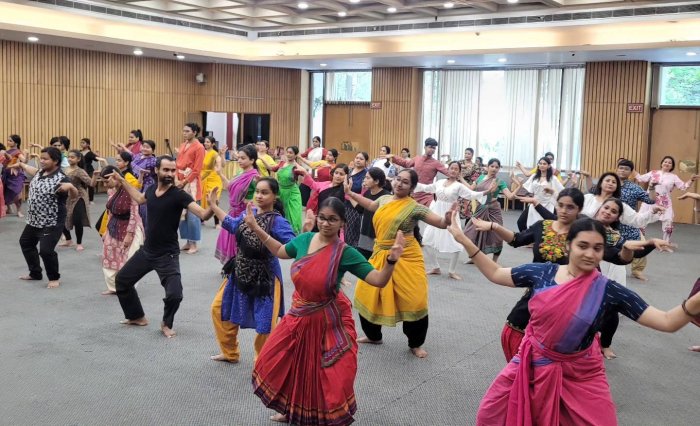 Sattriya workshop The pre-lunch Movement technique conducted by Sattriya dancer Prateesha Suresh, from all accounts, attracted a good number of dancers pertaining to different dance styles. 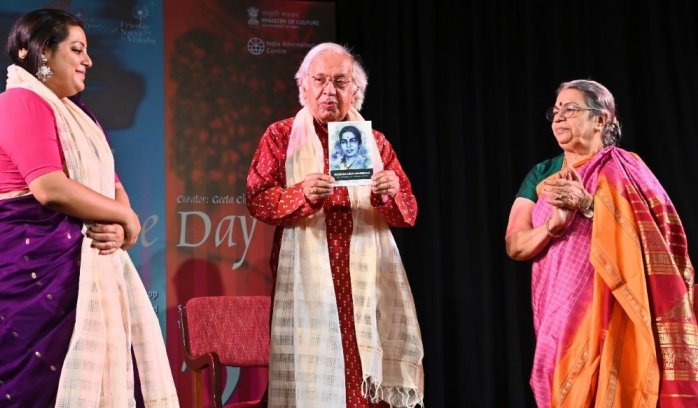 Trisha Niyogi, Ashok Vajpeyi, VR Devika The Rukmini Devi session began with a well-argued introductory address by veteran arts administrator, poet and President of Raza Foundation, Ashok Vajpeyi who, presented with a copy of V.R Devika's book earlier, was all praise for its succinct summing up of Rukmini Devi's work. He pointed out how India, at the beginning of the 20th century, had on the one side the greatness and perfection of tradition with geniuses like M.S.Subbalakshmi, complemented by imaginative pioneers with a holistic vision like Rukmini Devi, whose pioneering role in fashioning Modern India, was no less significant. He fully endorsed Devika's viewpoint of Rukmini Devi as Revivalist and Institution Builder. Much more than a dancer or choreographer, V.R.Devika in her book and lecture, started with the statement that Rukmini Devi, who impacted the world of handlooms, textiles and crafts, playing an important role as an animal welfare activist apart from being an institution builder and Educationist, does not need to be defended. The book details the kind of sacrifices and untiring effort involved in building Kalakshetra. Devika further emphasized that her sense of fairness was aghast at the western academic narrative of the 1970's and 80's, about Rukmini Devi entering an art arena, usurping an art exclusively meant for a community of Melakkarars, and making it available to others. She expressed that these are unjust accusations against one who had turned down the offer of being the first Woman President of India and who in the teeth of societal censure, as a mere sixteen year old, had proved her mettle by marrying George Arundale, a Christian Englishman 27 years her senior. Rukmini had the courage and honesty to turn down the World Mother role envisaged for her by the Theosophical Society and George Arundale, admitting that her initial tacit acceptance had not grasped the full nature of such a role and that whatever inner revelations she may have experienced were too deep and private to talk about. She however, with full conviction in her role of service to Society, retained the Devi affix assigned by Annie Besant. In the book, Devika writes about Rukmini's arduous training under Meenakshi Sundaram Pillai himself (whose acceptance of her as shishya entailed strong persuasion) had no short cuts. Her repositioning of the dance for the proscenium, while retaining its spiritual essence, was a big step in making it part of the regenerative process of national reform. Rukmini Devi institutionalized and threw open the learning of the dance and its corollary aspects of music, nattuvangam, percussion, to all aspirants irrespective of class (in a holistic Kalakshetra where Nature, the crafts and arts, dance and music, and education worked together), thereby creating an environment for fashioning young minds for India's cultural renaissance - as important as independence. 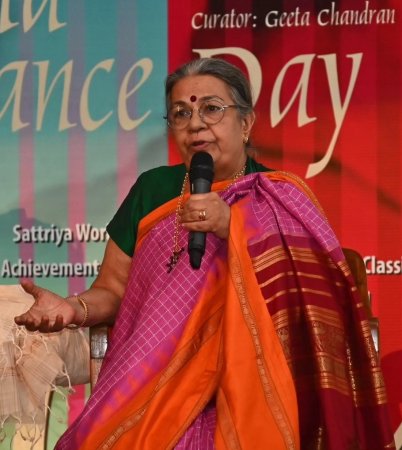 VR Devika Devika emphasized in her talk that the tag of Sanskritizing the dance (with Abhinaya Darpana as part of the students' curriculum in Kalakshetra) ascribed to Rukmini Devi, was also not based on facts when in the Brihadeeswara Temple and early 10th to 12th century temples full of Karana postures on the walls, below each sculpture was the inscribed relevant Sanskrit quote from the Natya Sastra! Besides, it was at the behest of Guru Meenakshi Sundaram Pillai that Rukmini Devi made Abhinaya Darpana compulsory part of the training in Kalakshetra. The oft made criticism against Rukmini Devi of sanitizing the dance by removing the sringar element which was its forte again showed lack of understanding for the intrinsic nature of the dance - for Padams and Javalis taught by Gowri Ammal to Kalakshetra students were all sringar items. The Keertanam in Bharatanatyam introduced by Rukmini Devi, Ananda Nadana Prakasham on Nataraja, her favourite deity, was composed by Meenakshi Sundaram Pillai himself. Rukmini Devi herself, as pointed out in the book, sang and danced the Kshetrayya padam Manchi dinamu nede during her own maiden performance. One cannot say that a person who composed a dance drama based on Jayadeva's Gita Govindam shied away from sringar! Besides, Bharatanatyam compositions are a layered combination of sringar and bhakti to be viewed in totality and not in isolation. Kalakshetra teaching faithfully followed the Margam prescribed by Nattuvanars and the founding Kalakshetra teachers starting from Meenakshi Sundaram Pillai, followed by Ponniah Pillai, Chokkalingam Pillai, Muthukumara Pillai and so on were all from the traditional family of Nattuvanars. Devika also added, "Presentation aesthetics was Rukmini Devi's strong point. The stage with Nataraja, Rukmini's favourite deity on a pedestal, with dance accompanists visibly seated in view, on the left side of the stage, leaving the open stage space for the dancer, and her innovative genius displayed in the dance drama realm which has become synonymous with Kalakshetra, are her sole contribution. Built on the bedrock of music composed by the finest of musical brains, the dance composition, the subdued aesthetics in costume designing and stage décor are all of the highest order." Devika also pointed out that contrary to the narrative woven, Rukmini Devi had great respect for hereditary artistes. Finally, the word Bharatanatyam was not her coinage as widely believed. The great 15th century poet Purandaradasa himself had used the term Bharatanatyam. In telling brevity, the book brings out the life of Rukmini Devi whose curiosity had never been stirred by tattukazhi sounds in her neighbourhood, nor had she been witness to music/dance ensembles in weddings which she heard about. She was however highly sensitized to music thanks to her mother Sheshammal who came from a musical family. Growing up amidst father Neelakantha Shastri's very traditional outlook, fate seemed to take a hand with young Rukmini's eyes opening out to a new esoteric world, when she came into contact with Annie Besant and the Theosophical Society, and of course George Arundale who had a main hand in grooming Rukmini's ideas, particularly on education - seen in full play in the Besant Theosophical School started on June 27, 1934, which stressed on making the learning process one of joy without corporal punishment. Its fearless approach, opening the child's mind to beauty and creativity was to groom youngsters to serve a newly emerging India. Devika's lively writing puts frequently heard facts on Rukmini Devi's life, into the right perspective. Interspersed with some startling revelations, this book comprises yeoman service to dance history showing Rukmini Devi in her rightful place as Arts Revivalist and Institution Builder. What a contribution by the Niyogi Book Series, for publishing such a work and selling it for such a modest sum bringing the book within the reach of all readers! TRANSMISSION OF DANCE TRADITIONS The seminar on Legacy in Classical Dance had a reputed panel of dancers with Geeta Chandran competently moderating the session. If the word Legacy, as mentioned in the dictionary means a handing over by a predecessor, every movement or knowledge system has had pioneers who have passed on their learning to inheritors who in turn as propagators have created the next generation of beneficiaries. Starting from Guru Sadanam Balakrishnan - the Kathakali doyenne just decorated with a Padma Bhushan - to Dr. Anita Ratnam, the panel comprised Roja Kannan, Indira Kadambi, Dr.Neena Prasad and Prateesha Suresh. Geeta divided the discussion to two parts, the first on acquiring the legacy and the second on passing it on to another generation. It emerged that all had imbibed from more than one Guru, and some had learnt more than one form, before finally settling on the dance each has specialized in. Another clear factor that emerged was of each person's dance carrying the influences of different teachers.  Geeta Chandran 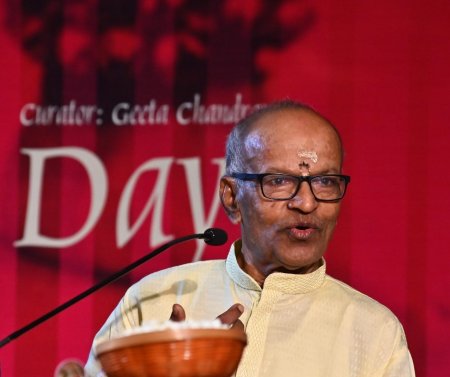 Sadanam Balakrishnan Each teacher is different in his own way, Guru Sadanam Balakrishnan pointed out and one imbibes from each guru. No two persons are the same, even while executing the same item. To learn with diligence and to never attempt to copy any great performer, but to understand and internalize what was taught -leading to one's own personal interpretation, was important. In passing on the legacy, he mentioned how one had to adapt to changing situations. For instance the teaching in Delhi had to be effective without the benefit of the type of oil massage Kalamandalam students went through, as a compulsory part of their training. Roja Kannan studied under Guru Adyar K. Lakshman, who was strict about not wavering from the Kalakshetra style he was moulded by and did not permit the slightest deviation in his own compositions carrying the imprint of his singing ability with sprightly jatis built with his expertise in nattuvangam. While this adherence was inviolable, he allowed students the freedom to innovate in their own creations - plus he had the open mind to send his students to Kalanidhi Narayanan for more expertise in abhinaya. Roja showed how she had also benefited by working with other Bharatanatyam experts like late Lakshmi Viswanathan. 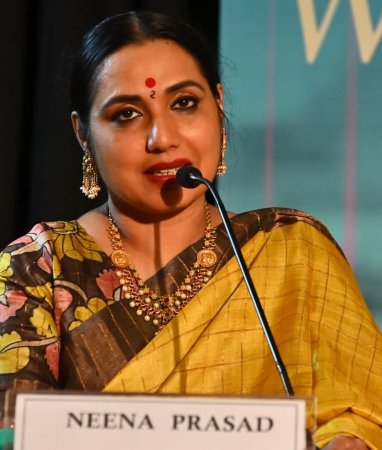 Neena Prasad Mohiniattam expert Neena Prasad referring to how her dance carried the reconciled impact of Kalamandalam Sugandhi, her teacher of the then still evolving two different Mohiniattam styles- Kalyanikutty Amma's style flowing from Krishnan Panicker and Chinnammu Amma's style stemming from Satyabhama. Even the araimandi was different. She herself was already fortified with the strong sub-text evolving from prior Bharatanatyam training under Guru Adyar Lakshman from whom she imbibed all the 'kanakku' or arithmetic of jatis, also learning Kuchipudi and some Kathakali. She mentioned that in passing on this legacy, the challenge lay in finding ways of communicating to people hailing from different backgrounds and cultures, the inner spirit of a form fashioned by the poetry of the language it is expressed in - how to convey the ache of a nayika separation in a Swati Tirunal composition! Prateesha Suresh who had learnt another dance form before coming to Assam's Sattriya, spoke of how a dance form fashioned within the seclusion of the Sattras, by coming to proscenium space, had acquired its own challenges, with females being allowed into a male preserve and abhinaya coming in. Besides, what emerged from a religious background had now to acquire a text prescribing stylistic features. Indira Kadambi spoke of the joy of learning Bharatanatyam under Narmada, very different from the later abhinaya training under Kalanidhi Narayanan, who insisted on a sense of humour even in presenting the khandita heroine. The understanding of abhinaya to be passed on to the next generation is always difficult for it deals with the inner dancer, and how this aspect which forms a major part of Indira's teaching is taught, was not very clear from what she said.  L-R: Roja Kannan, Neena Prasad, Geeta Chandran, Sadanam Balakrishnan, Anita Ratnam, Prateesha Suresh, Indira Kadambi Anita Ratnam's approach was totally different. She spoke of the urge to try out one's own ideas, prompting her creative energies to deviate from the exactitude of the Kalakshetra Bani to which her Guru Adyar Lakshman belonged. He would not permit anything different from what was taught, though it was on the bodies of the twosome of her sister and herself, that the Guru had mounted many of his own compositions based on Madurai Krishnan's music! She was the only dancer who spoke of free thinking and pioneering thanks to forward looking parents. Her teaching now involved dancers from varying backgrounds and she spoke of how her broadcasts in the United States had changed her mind and she was made aware of how technology impacts legacy. She spoke of Digital Space, other parallel spaces, and of dealing with youngsters who want to be social reformers. She referred to Archiving and Documentation being so important in passing on Dance Legacy. What emerged through the discussions was that any legacy in transition is bound to reflect changes over time - some subtle and some stronger. IMMACULATE PERFORMANCE A hearty aspect, for this critic, of the two day festival of evening performances was in the packed auditorium with people even seated in the aisles, with an attentive audience chiming in with prolonged applause after each recital. 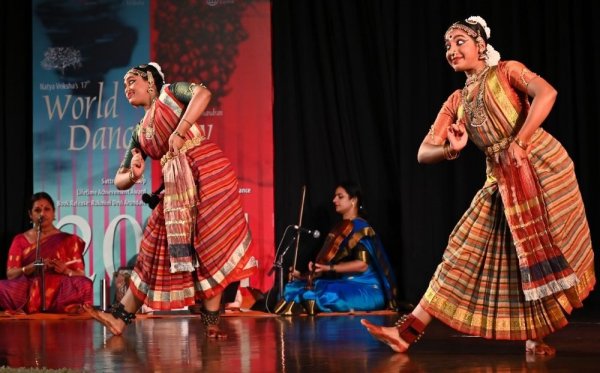 Vaishnavi Srinivasan and Nivedha Harish The young dancers Vaishnavi Srinivasan and Nivedha Harish, students of Roja Kannan, were a pleasure to watch. Immaculate in their nritta, their combined presentation in perfect symmetry made for a joyful presentation. As for the abhinaya segments, with each of the two, alternately expressing each sahitya line, they were a foil for each other in their independent inner approaches reflected on their faces, even while the language of mudras was the same. The duo started with a stunningly executed Adyar Lakshman composition built on the Guru's expertise in singing and nattuvangam - Stuti Pancharatnam, a ragamalika and talamalika, offering homage to Ganapati, Murugan, Shiva, Devi and Vishnu as Krishna with the Gopis, in that order, punctuated with sparkling jatis. This was followed by a superb rendition of the Husseni Swarajati E Mayaladira Sami nekemani bodhincewra na sami wherein the khandita, addressing the Lord, wants to know who has poisoned his mind against her. 'Has the lotus eyed woman, with some potion secretly given to you, made you forget my true love?,' she asks. Roja Kannan mentioned the background to this presentation. Lakshmi Viswanathan was engaged in research and collecting information on the Tanjavur tradition of hereditary artistes like Gyana. During that process, while working on recreating the abhinaya part of this swarajati, an original Tanjavur Quartette creation, she asked Roja Kannan with whom she shared a good relationship, to join with the two students Lakshmi had seen perform earlier - on whom she could try out the organic progression of abhinaya ideas picked up during her research. Retaining the jatis as set by Kalakshetra, Roja Kannan, with Vaishnavi and Nivedha, reaped the full benefit of Lakshmi's work with her incisive interpretative capacity. Sadly, Lakshmi, as fate would have it, passed away before being treated to the finished Swarajati as set by Roja with her disciples. Allowing alternately for the individual interpretative expression of the sahitya lines (which was what Lakshmi had suggested) one saw how each dancer's thought process was different in emphasis - though both used the same hand gestures. The jati punctuations on the other hand, with finished movements, had a synchronized uniformity, holding the audience enthralled. Roja's nattuvangam clarity along with the melody soaked singing of Janani Hamsini Narasimha trained under Ranjani/Gayatri, with T.V.Sukanya on violin and Chandrashekaran on mridangam, made for superbly synchronized accompaniment for the dance. DANCING BODY HAS NO GENDER 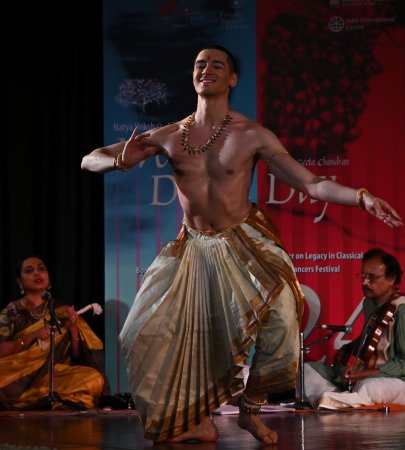 Thomas Vo Van Tao The other young dancer, an unlikely male performer in the very female bastion of Mohiniattam, Thomas Vo Van Tao, a disciple of Dr.Neena Prasad, proved that gender is more in the mind of the watcher. Tall, with a lean body (very suited to Bharatanayam was how a Mohiniattam expert remarked) the finest part of the performance was that the dancer did not think of himself in gender terms. His body was just an instrument of dance, and never did one get a feeling of a male dancer trying to masquerade as female. Dancing without a shred of self- consciousness, turned out, waist down in an off white costume, with fan frills on one side, with the torso left bare, with one long thin necklace as the minimum of jewelry, Thomas began with Cholkettu in Gambhira Nattai set to misrajati triputa talam with homage to Ganapati. Continuing with another Changanacheri Madhavan Namboothiri composition (composer of almost all of Neena Prasad's repertoire) the dancer presented the central piece - a Sthava varnam in Shankarabharanam set to adi talam in the devotional mood. Leading from an Arjuna/Anjaneya altercation about who should take credit for constructing the bridge across the river, enabling Rama and his army of monkeys to cross over to Lanka to fight Ravana and free Sita, Arjuna fashions a bridge which even Anjaneya cannot break. The realization sets in that it is ultimately Rama's will and blessings powering both efforts - without which neither would succeed. With the easily swaying body and very expressive, Thomas gave a convincing performance with Neena Prasad providing the nattuvangam lead with Ananda Mura as singer, Ramamurthy Keshavan on mridangam and V.S.K Annadorai on the violin. Sringar in the pangs of Nayika viraha through a Swati Tirunal composition 'Aliveni endu seivu anda Jnani manini vandillo' could be captured in its internalized intensity, was the final proof of how much with the spirit of Mohiniattam this male dancer from a foreign culture is. A feather in Neena Prasad's cap too! KATHAK PROFICIENCY LOST COUNT OF TIME 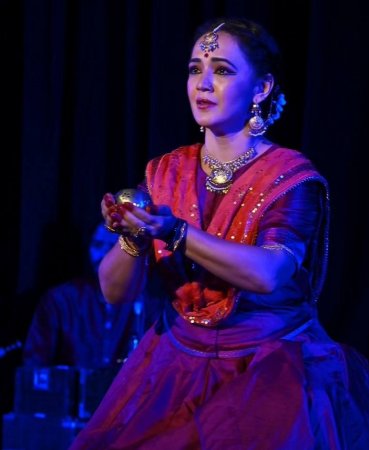 Divya Goswami Divya Goswami, a student of late Munna Shukla, is an extremely talented Kathak dancer. But she failed to realize that a recital with the technical expertise of nritta in teental, followed by her very dramatized introduction of the Soni Mahiwal love story, synonymous to Punjab (of one called Soni, not because she was beautiful but because she defined beauty) to conclude with a prolonged but very well executed one man dance theatre kind of presentation, fashioned on the immortal poetry of Fazal Shah, was much more than what the concluding recital at the end of a long day, could accommodate. The organizers were left cajoling a restless IIC staff having to stay on duty far beyond the usual closure time, to serve dinner to the invited festival guests. Undoubtedly a gifted story teller, Divya's long introduction could have made what came later almost an anti-climax. Choreographed with suggestions from the experienced Kamalini Dutt, the production based on selected verses from Fazal Shah's epoch making work Soni Mahiwal, was mounted on Bangalore Praveen D. Rao's musical score, rendered by an accomplished group of musicians from outside Delhi (the capital has never been known for its music for Kathak). The dulcet voiced singer in his bhav-soaked rendition, with the other accompanists, along with Divya's deeply involved abhinaya made for a powerful combination, though the totality, particularly the part involving Soni's crossing of the river to get to the other shore to meet Mahiwal, with her anchor of the 'kuchha mitti ghada' dissolving leaving her rudderless, and a helpless prey for crocodiles, called for drastic editing. Whether the prolonged treatment was exaggerated by music cues lost with musicians repeating parts, as told to me, was not clear. But somewhere, a powerful production, lost out through some unwise programming. FINALE OF BHARATANATYAM BY MEERA SREENARAYANAN 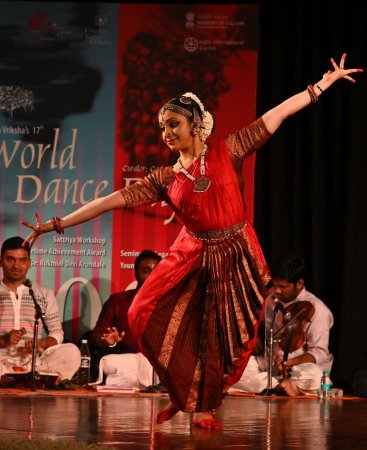 Meera Sreenarayanan Regarding the Bharatanatyam dancer Meera Sreenarayanan's debut performance some years ago in the Madras Music Academy presenting the same famous varnam she danced for the Youth Festival, "Danike taku janara" in Todi ragam - greeted by the non-stop thunderous applause from a highly moved audience, for a new 'star' in the dance firmament. In this varnam the nayika addressing King Shivaji Maharaj as a messenger, with tongue-in-cheek advocacy of 'that beauteous woman who is the ideal mate for you' is in reality flirting, offering herself. Meera's subtle treatment of this varnam held one and all enthralled. Now, the dancer dazzles, with glistening tears in her eyes and a few drops trickling down her cheeks during abhinaya, executing sizzling jatis in computerized perfection. But I do not want to be dazzled, I want to be moved. Rather than tears in her eyes, I would like to be moved to tears by the dance. Dance is a very fragile art, and any disproportionate emphasis on its delicately balanced ingredients, can lead to a lessening of its impact. Now adorned with many coveted recognitions, one would hope that this exceptionally gifted dancer does not miss the wood for the trees. The dancer's ending with C.V. Chandrashekar's tillana composition in Simhendramadhyamam, with the dancer's sheer virtuosity won applause, and a big thank you to Natya Vriksha for this prodigious effort.  Writing on the dance scene for the last forty years, Leela Venkataraman's incisive comments on performances of all dance forms, participation in dance discussions both in India and abroad, and as a regular contributor to Hindu Friday Review, journals like Sruti and Nartanam, makes her voice respected for its balanced critiquing. She is the author of several books like Indian Classical dance: Tradition in Transition, Classical Dance in India and Indian Classical dance: The Renaissance and Beyond. Response * Dearest Leela Maami and Anita! Read both of your wonderful reviews. Thank you for your observations. Apology for not communicating my thoughts clearly. For me personally, apart from sharing my learnings of my Gurus with my students, I try working on tapping that joy of expressing one's individuality... to be one self...the happy self! The process of which is a long and beautiful journey that one should dive deep into without being attached to performances, name, fame. I hope I am clear. Thank you. - Indira Kadambi (May 6, 2024) Post your comments Pl provide your name and email id along with your comment. All appropriate comments posted with name and email id in the blog will also be featured in the site. |